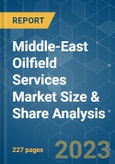The Middle East oilfield services market is projected to register a CAGR of over 5.5% during the forecast period.
COVID-19 negatively impacted the market in 2020. Presently, the market has reached pre-pandemic levels.
COVID-19 negatively impacted the market in 2020. Presently, the market has reached pre-pandemic levels.
- Over the medium term, the rising investments aimed at increasing production capacity are expected to increase the demand for the Middle East oilfield services market.
- On the other hand, the increasing adaptation of renewable energy sources such as solar and wind energy is expected to hinder market growth.
- Nevertheless, the increasing technological investments in the market to develop more efficient oil production and drilling processes are expected to create huge opportunities for the Middle-East oilfield services market.
- Saudi Arabia is expected to dominate the market during the forecasted period due to the country's significant amount of proven oil and gas reserves.
Middle-East Oilfield Services Market Trends
Completion and Production Services Expected to Witness Significant Growth
- Well-completion services aim to extract the maximum amount of original oil in place economically (OOIP), regardless of the complexity of the well. Once a well has been drilled, evaluated, cased, and cemented, completion services involve adding equipment to optimize production. Once the well is completed and production begins, bringing hydrocarbons to the surface will start. The production services keep the well running and sustaining for a long time.
- During the forecast period, the demand for completion services is anticipated to surge, primarily due to the increasing number of exploration and production projects in the Middle East. For example, in 2021, the Middle East region worked on approximately 41 oil and gas contracts, with upstream projects accounting for most of the contracts at over 31.
- According to Baker Hughes rig count, the average rig count in the Middle East increased significantly in 2022 compared to 2021. In 2022, the average number of rigs was 308, an increase of 16.3% compared to 2021.
- Moreover, expanding offshore fields in the Middle East is anticipated to bolster demand for artificial lift production services. In 2022, Saudi Arabia and Kuwait announced plans to develop the Durra offshore gas field, which was projected to yield 1 billion cubic feet of gas and 84,000 barrels of condensate per day.
- In 2022, the Abu Dhabi National Oil Company (ADNOC) announced the discovery of natural gas resources offshore the Emirates of Abu Dhabi. This is the first discovery from the country’s offshore exploration concessions, highlighting the success of ADNOC’s block bid rounds. This exploration well has indicated between 1.5 and 2 trillion standard cubic feet (TSCF) of raw gas in place.
- Therefore, in the forecast period, completion and production services in the Middle East are expected to expand, fueled by a surge in upstream projects as a result of the global increase in demand and price of hydrocarbons.
Saudi Arabia to Witness Significant Growth
- In 2021, Saudi Arabia, which is home to the second-largest proven oil reserves globally after Venezuela, was the world's second-largest crude oil producer, responsible for approximately 11% of global crude oil output. Additionally, the country holds the top spot as the largest crude oil exporter globally.
- Saudi Arabia is estimated to have the world's fifth-largest estimated shale gas reserve. Thus, it has great potential to replicate the United States' unconventional reserves' development growth.
- In February 2022, Saudi Aramco made significant strides in the development of its natural gas sector by discovering natural gas fields in four regions of the Kingdom, namely in Shadoon (the central region), Shehab and Shurfa (the southeast region), Umm Khansar (near the northern border with Iraq), and Samna (the eastern region). This discovery is expected to boost demand for oilfield services, driving the market in the forecast period.
- According to the Organization of the Petroleum Exporting Countries (OPEC), crude oil production in Saudi Arabia was 9,125 thousand barrels per day, which was a 1% drop compared to 2020. But production is expected to increase in the future due to oil and gas field expansion.
- Saudi Arabia is in the process of expanding its existing oil and gas fields. A few major expansion projects include the Berri field and the Marjan oil field. The Berri field is located partly onshore and partly offshore on the east coast of Saudi Arabia and is being expanded under the Berri Increment Program (BIP) to double its crude production capacity to 500,000 barrels per day (bpd) by 2023. The project is scheduled to be completed in 2023, with an estimated investment of USD 6 billion.
- Therefore, due to the above-mentioned points, Saudi Arabia is expected to witness significant growth in the oilfield services market during the forecasted period.
Middle-East Oilfield Services Industry Overview
The Middle-East oilfield services market is fragmented in nature. Some of the major players in the market (in no particular order) include Baker Hughes Co., Halliburton Company, Schlumberger Limited, Middle-East Oilfield Services, and Weatherford International PLC.Additional Benefits:
- The market estimate (ME) sheet in Excel format
- 3 months of analyst support
Table of Contents
1 INTRODUCTION
4 MARKET OVERVIEW
5 MARKET SEGMENTATION
6 COMPETITIVE LANDSCAPE
Companies Mentioned (Partial List)
A selection of companies mentioned in this report includes, but is not limited to:
- Anton Oilfield Services (Group) Ltd.
- Baker Hughes Co.
- Denholm Oilfield Services
- Halliburton Company
- Middle East Oilfield Services
- Welltec A/S
- OiLServ Limited
- Schlumberger Limited
- Swire Oilfield Services Ltd.
- Weatherford International PLC
Methodology

LOADING...










